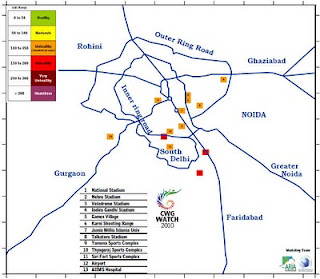Daily Air Pollution Forecasts for Delhi
An advanced notification system on daily air quality is developed for the National Capital Region (NCR) of Delhi, under the "Clean Air for Delhi 2010 and Beyond" program. The program is being developed with technical collaboration between two French firms - Aria Technologies SA and Leosphere SA, and the Central Pollution Control Board (CPCB) in Delhi, India, with financial support from the Government of France. The system is now operational and delivering valuable information in support of the Commonwealth Games in October, 2010.
The Aria Technologies SA have previously developed similar system for Beijing, which became operational during the Olympic games in 2008 and are also developing one for Rio de Janeiro (Brazil) as part of the Olympics 2016 preparations.

Current air pollution levels at Delhi's four monitoring stations
@ Income Tax Office
@ Central Pollution Control Board
@ Delhi College of Engineering
@ Siri Fort Sports Complex
This forecasting program is designed to provide pollution alerts to the public and the media and hopefully minimize the instances of higher health impacts in the future for better health. As part of the outputs, the air quality index (AQI) ranging between 0 and 500, is also estimated for various parts of the city and published as a common denominator for multiple pollutants. The system is also utilized for air pollution management by studying scenarios to control pollution and evaluate the impacts of implementation of projects on air quality. Click on the scale for an analysis report for Delhi.
Related Content
- Heavy rain to sweep across Delhi today, air quality to dip further
- Delhi: Improved air quality index worsens by evening; wind speed slows down
- Delhi heat wave is result of increased pollution in the capital city
- On World Environment Day, CSE warns Delhi’s air pollution and congestion crisis will worsen this decade if urgent action is not taken
- Here come the "number crunchers"
- Air Pollution in the Month of October is Getting Worse - is Delhi Ready?


